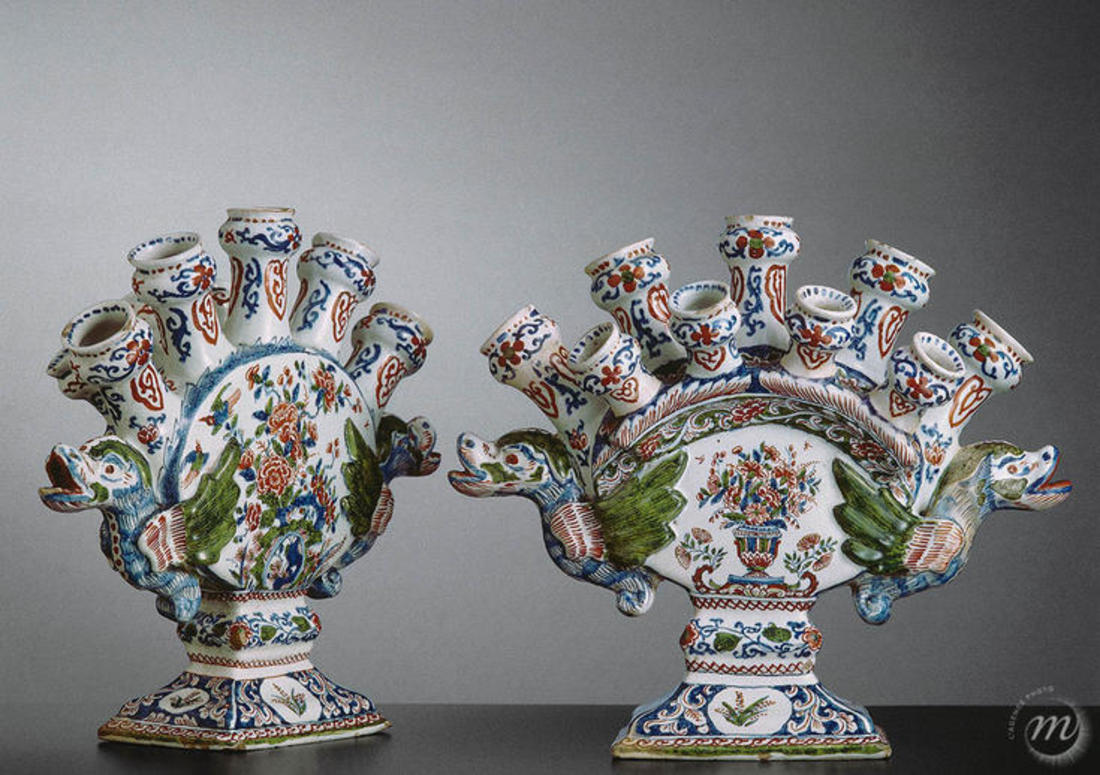Each vase rests on a rectangular base and presents a flared shape. At the top, two rows of spouts can be found, in which tulip stems are to be inserted. They are decorated on both sides with birds and polychromatic flowers. The handles are shaped like two ducks.
This type of vase for tulips was invented in Delft, one of the most important hubs for the creation of ceramics in Europe. Delft earthenware makers designed this piece in response to the fashion for tulips.
From the 17th century onwards, the Dutch West India Company, whose purpose was to trade with remote countries, brought back the first tulip bulbs from Asia. From then on, a veritable tulipomania took hold! This rare flower, presenting more than 120 species, became the subject of flourishing trade and a profitable investment …
These were purchased on a forward basis – in other words, the transaction did not concern the bulb, but the subsequent production. As a result of speculation, prices sky-rocketed and soon, a single bulb of a rare species was worth more than a house or a Rembrandt painting. The first stock-market crash in history took place in 1637, thanks to a flower now considered commonplace!
Our two tulipières were created nearly a century after this episode. However, even in the 18th century, it was fashionable for the elite to present bouquets of tulips in their homes.
Related document : This type of tulipière has been made to hold cut flowers. However, the bulbs themselves could be planted and grown in certain large models, reaching heights of up to 1.5 m (Victoria and Albert Museum, London).

Each vase rests on a rectangular base and presents a flared shape. At the top, two rows of spouts can be found, in which tulip stems are to be inserted. They are decorated on both sides with birds and polychromatic flowers. The handles are shaped like two ducks.
This type of vase for tulips was invented in Delft, one of the most important hubs for the creation of ceramics in Europe. Delft earthenware makers designed this piece in response to the fashion for tulips.
From the 17th century onwards, the Dutch West India Company, whose purpose was to trade with remote countries, brought back the first tulip bulbs from Asia. From then on, a veritable tulipomania took hold! This rare flower, presenting more than 120 species, became the subject of flourishing trade and a profitable investment …
These were purchased on a forward basis – in other words, the transaction did not concern the bulb, but the subsequent production. As a result of speculation, prices sky-rocketed and soon, a single bulb of a rare species was worth more than a house or a Rembrandt painting. The first stock-market crash in history took place in 1637, thanks to a flower now considered commonplace!
Our two tulipières were created nearly a century after this episode. However, even in the 18th century, it was fashionable for the elite to present bouquets of tulips in their homes.
Related document : This type of tulipière has been made to hold cut flowers. However, the bulbs themselves could be planted and grown in certain large models, reaching heights of up to 1.5 m (Victoria and Albert Museum, London).